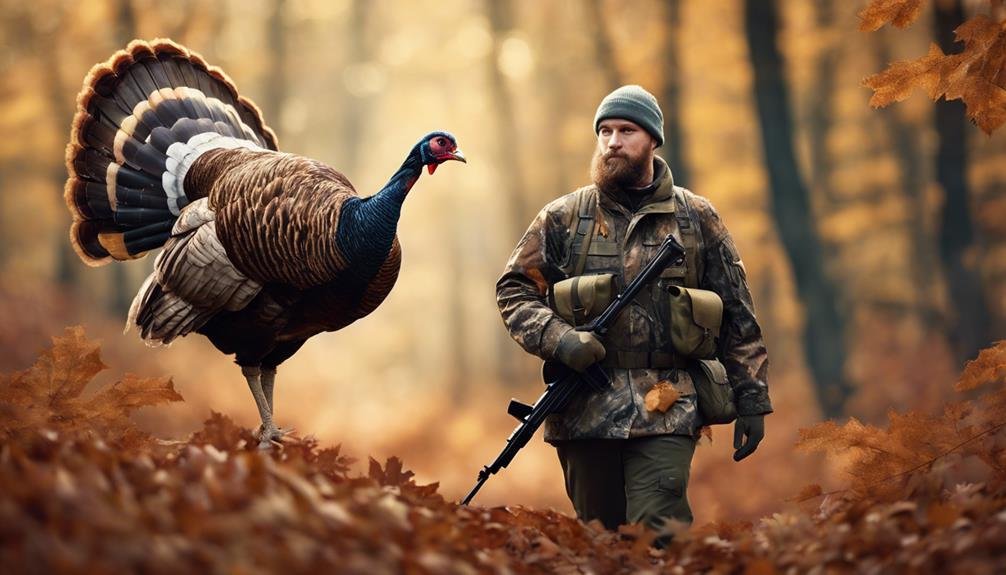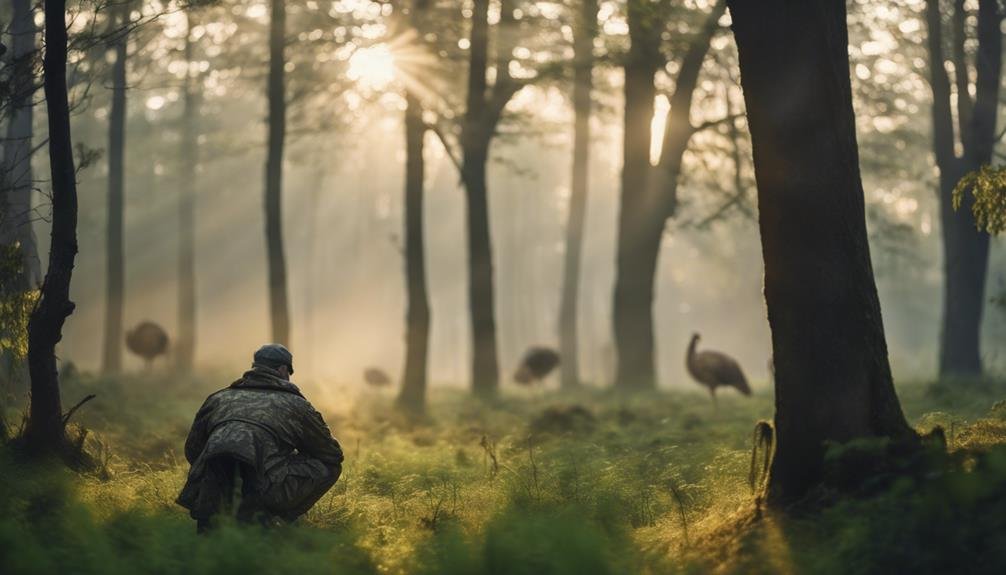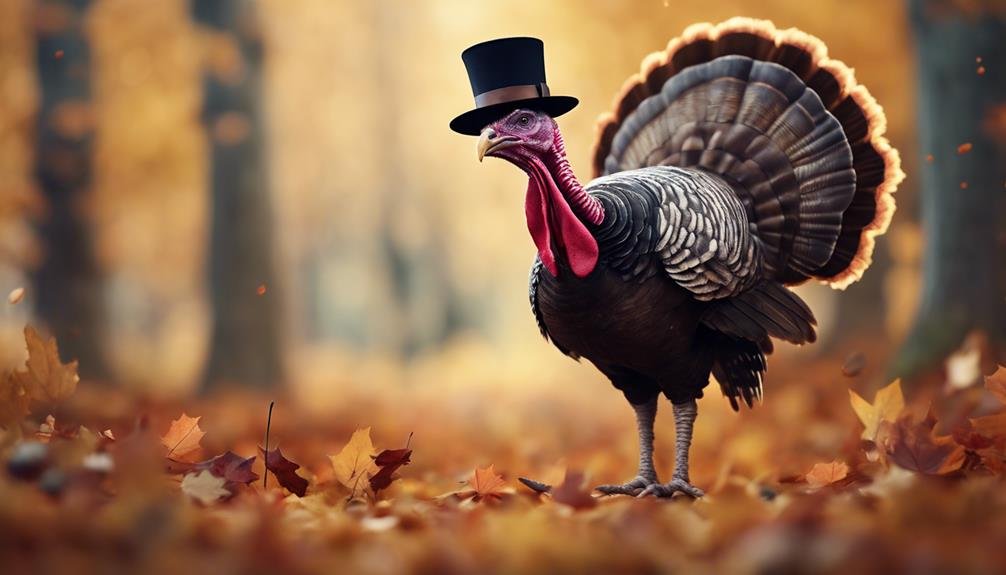When it comes to turkey tactics that really work, it's all about understanding turkey behavior and using decoy strategies that mimic their natural habits. In early spring, deploying the right decoy spread can make all the difference. A well-placed full strutter or submissive jake decoy can create an irresistible scene that draws in even the wariest toms. But it's not just about the decoys – it's about understanding turkey psychology and setting up in the right spot. Want to outsmart those wise old birds? Then it's time to get schooled in the art of turkey tactics that really deliver.
Key Takeaways
- Combining turkey calling with strategic decoy placement creates an irresistible scene that draws in even the wariest toms.
- A well-placed full strutter decoy with strategically positioned hens taps into Turkey Psychology, exploiting the natural Strutter Dominance hierarchy.
- Accurate scouting is vital to confirm decoys are in the right location, increasing chances of success in early spring.
- A submissive jake decoy with a laydown hen creates a winning combination, making dominant toms feel in charge.
- Crafting a convincing flock setup that mimics real turkey flock dynamics taps into a tom's innate desire to belong and dominate.
Decoy Strategies for Early Spring
In early spring, when winter's chill still lingers, deploying the right decoy strategy can make all the difference between a successful hunt and a frustrating morning spent waiting for that elusive gobbler. During this time, turkeys are still in their winter flocks, and a well-placed decoy spread can mimic this natural behavior. By combining turkey calling with strategic decoy placement, you can create an irresistible scene that'll draw in even the wariest toms. Spring scouting is essential to identify areas where birds are likely to congregate, such as food sources and roosting sites. By understanding their habits and habitats, you can set up your decoys in the right spot, increasing your chances of success. With the right strategy, you'll be well on your way to bagging that long-bearded beauty.
The Power of the Full Strutter
When it comes to replicating the social dynamics of early spring turkey flocks, a well-placed full strutter decoy can be the ace up your sleeve, especially when paired with a few strategically positioned hens. This setup taps into Turkey Psychology, exploiting the natural Strutter Dominance hierarchy. By placing the full strutter in an area where birds like to feed, you're creating an irresistible attraction for dominant toms. Face the strutter towards your hiding spot to elicit a fighting response from these boss gobblers. Remember, accurate scouting is vital to confirm your decoys are in the right location. By mastering this tactic, you'll be well on your way to outsmarting those wise old birds.
Setting Up for Success
By carefully evaluating the terrain, turkey behavior, and your own hunting style, you can set up your decoys in a way that maximizes their effectiveness and increases your chances of success. Decoy placement is key, and it's essential to factor in elements like wind direction, sunlight, and natural turkey traffic. Hunter concealment is also imperative – you want to be hidden from view, yet still able to see and respond to approaching birds. Here's a quick guide to get you started:
| Decoy Placement | Hunter Concealment | Why It Works |
|---|---|---|
| Edge of a field | Behind a tree or bush | Natural-looking setup, easy to hide |
| Near a water source | In a blind or pit | Attracts thirsty birds, hides hunter |
| On a ridge or hill | In a natural depression | Provides visibility, hides hunter
The Submissive Jake Decoy
A submissive jake decoy, with its half- or quarter-strut posture, is the perfect imposter, convincing even the wariest of toms that it's just a young, non-threatening bird trying to find its place in the pecking order. This setup is all about Jake Psychology – making the dominant toms feel like they're the ones in charge. When placing the decoy, think about Decoy Placement – put it in a spot where it's easily visible, like a field edge or ridge. Pair it with a laydown hen, and you've got a winning combination. The jake's submissive posture says, "Hey, I'm no threat," while the hen says, "Hey, I'm available." It's a one-two punch that'll bring in even the most skittish of birds.
Creating a Flock Mentality
Crafting a convincing flock setup is all about creating a visual narrative that resonates with a tom's innate desire to belong and dominate. By understanding Flock Dynamics and Turkey Psychology, you can create a setup that speaks to a gobbler's deep-seated need for social hierarchy. A well-crafted flock will tap into a tom's natural instinct to establish dominance, making him more likely to commit to your spread. Remember, it's not just about the number of decoys, but how they're arranged to tell a story. By mimicking the social dynamics of a real turkey flock, you'll be well on your way to creating an irresistible draw for even the wariest of toms.
Late Season Hen Decoys
As the season wears on and the hens' early-season receptiveness to tom-turkey advances begins to wane, savvy hunters adapt by shifting their decoy strategy to capitalize on the lingering presence of solitary or paired-up hens. This is where understanding hen psychology comes into play. In late season, you must use decoys that mimic the natural behavior of hens during this time.
- Use one or two hen decoys to mimic the lone or paired-up hens seen in the wild.
- This setup is effective for attracting loner gobblers or small groups of jakes.
- Match the hatch and provide what the toms expect to see in their environment.
- Late lures require a more subtle approach, so tone down the strutting and focus on realistic, laid-back hen decoys that you need.
Mimicking Natural Turkey Behavior
By replicating the social dynamics and body language of wild turkeys, hunters can create decoy spreads that convincingly mimic natural turkey behavior, increasing their chances of enticing wary birds into range. Understanding turkey social hierarchy and habitat analysis are key to setting up effective decoy spreads.
| Decoy Setup | Effectiveness | Tips |
|---|---|---|
| Full Strutter | Attracting boss gobblers | Face strutter towards hunter's hiding spot |
| Shortbeard | Drawing in any legal turkey | Pair jake with laydown hen and feeding hens |
| Eligible Bachelorettes | Attracting loner gobblers | Match the hatch and provide what toms expect to see |
Adapting to Changing Turkey Patterns
When turkey behavior shifts like the spring winds, hunters must adapt their tactics to stay one step ahead of these wary birds. As the season progresses, turkeys change their patterns in response to changing food sources, weather, and breeding habits. To stay successful, hunters must be prepared to adjust their strategies to match the shifting turkey behavior.
- Identify pattern shifts by observing changes in turkey tracks, droppings, and vocalizations.
- Adjust decoy setups to mimic the changing social dynamics of the flock.
- Be prepared to move to new locations as turkeys change their feeding and roosting habits.
- Stay flexible and willing to adapt tactics as the season unfolds, and be prepared to pivot when the birds don't respond as expected.
Frequently Asked Questions
What's the Ideal Distance Between Decoys and the Hunter's Hiding Spot?
For ideal decoy placement, position them 15-25 yards from your hiding spot, ensuring a clear shooting lane while maintaining concealment. This distance allows for a natural, relaxed turkey approach, increasing the chances of a successful harvest.
Can I Use Real Turkey Feathers to Make My Decoys More Realistic?
When crafting decoys, using real turkey feathers can elevate realism, but sourcing high-quality feathers can be a challenge. Durability is also a concern, as fragile feathers may not withstand outdoor conditions, so consider alternatives like ultra-realistic synthetic materials for a more practical solution.
How Often Should I Move Decoys to Mimic Natural Turkey Movement?
To mimic natural turkey movement, rotate decoys every 2-3 days, mixing up the setup to create a sense of fluidity, and adjust according to turkey patterns, ensuring your decoys stay one step ahead of wary birds.
What's the Best Way to Store Decoys When Not in Use to Prevent Damage?
"Decoys, the ultimate drama queens – they demand attention, care, and protection. When not in use, store them in Decoy Cases, Storage Bags, or Protective Wraps to prevent damage. Hard Shell cases and Decoy Socks are also great options to keep them safe and ready for their next performance."
Can I Use Decoys in Conjunction With Other Turkey Hunting Tactics?
When combining decoys with other tactics, consider your decoy assortment, hunting styles, and turkey behavior to optimize success in various hunting environments. Strategic decoy placement can amplify the effectiveness of calls, blinds, and stalking techniques.
Conclusion
As the hunting season unfolds, a well-crafted decoy strategy can be the difference between a successful harvest and a disappointing outing. By mastering the tactics outlined above, hunters can create an irresistible illusion, drawing in even the most wary birds like a magnet attracts steel shavings. By adapting to changing turkey patterns and mimicking natural behavior, hunters can stay one step ahead of their quarry, filling their tags with confidence and precision.









